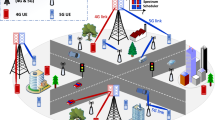Abstract
The Probability Distribution of Slot Selection (PDoSS) of IEEE 802.11 DCF is extremely uneven, which makes the packet collision probability very high. In this paper, we propose a novel RWBO+BEB backoff algorithm for 802.11 DCF to make the PDoSS even and thus decrease the packet collision probability. A Markov model is built for analyzing RWBO+BEB's PDoSS and saturation throughput. The model's correctness is validated by simulation. The performance of RWBO+BEB is also evaluated by simulation in terms of PDoSS, saturation throughput, packet collision probability and packet delay. The simulation results indicate that RWBO+BEB can decrease the packet collision probability to a large extent, utilize the channel more efficiently, and make the packet delay jitter much lower comparing to 802.11 DCF. Moreover, we analyze the relation of saturation throughput and packet collision probability to walking probability (p d ) and contention windows (w), respectively. The analysis indicates that RWBO+BEB has a remarkable feature: its saturation throughput keeps high, and packet collision probability keeps very low (which under 0.1) in a large range of p d and w, this allows us to configure p d and w more flexibly.
Similar content being viewed by others
References
IEEE Standard for Wireless LAN Medium Access Control (MAC) and Physical Layer (PHY) Specifications, 1999 Edition.
Y. Tay and K. Chua, “A Capacity Analysis for the IEEE 802.11 MAC Protocol”, Wireless Networks, Vol. 7, No. 2, pp. 159–171, 2001.
G. Bianchi, “IEEE 802.11 – Saturation Throughput Analysis”, IEEE Communication Letters, Vol. 2, pp. 318–320, 1998.
G. Binachi, “Performance Analysis of the IEEE 802.11 Distributed Coordination Function”, IEEE Journal on Selected Areas in Commu., Vol. 18, No. 3, pp. 535–547, March 2000.
Haitao Wu, Yong Peng, Keping Long et al., “Performance of Reliable Transport Protocol over IEEE 802.11 Wireless LAN: Analysis and Enhancement”, IEEE INFOCOM'02, Vol. 2, pp. 599–607, 2002.
Fengji Ye, Su Yi, Sikdar, B, “Improving Spatial Reuse of IEEE 802.11 Based Ad Hoc Networks”, IEEE GLOBECOM'03, Vol. 2, pp. 1013–1017, 2003.
Y. Wang and B. Bensaou, “Achieving Fairness in IEEE 802.11 DFWMAC with Variable Packet Lengths”, IEEE GLOBECOM'01, Vol. 6, pp. 3588–3593, 2001.
Thyagarajan Nandagopal, Tae-Eun Kim, Xia Gao, and Vaduvur Bharghavan, “Achieving MAC Layer Fairness in Wireless Packet Networks”, in Proc. ACM MobiCom'00, Boston, MA, August 2000, pp. 87–98
Shugong Xu and Tarek Saadawi, “Does the IEEE 802.11 MAC Protocol Works Well in Multihop Wireless ad hoc Networks?” IEEE Communications Magazine, Vol. 39, No. 6, pp. 130–137, 2001.
S. Mangold, S. Choi, P. May, O. Klein, G. Hiertz, and L. Stibor, “IEEE 802.11e Wireless LAN for Quality of Service (invited paper)”, in Proceedings of the European Wireless, Florence, Italy, February 2002, Vol. 1, pp. 32–39.
Jie Hui and M. Devetsikiotis, “Designing Improved MAC Packet Schedulers for 802.11e WLAN”, IEEE GLOBECOM'03, Vol. 1, pp. 184–189, 2003.
Liyun, Long Ke-ping, Wu Shi-qi, and Chen Qina-bin, “Performance Analysis and Improvement of IEEE 802.11 DCF”, Acta Electronica Sinica, Vol. 31, No. 10, pp. 1446–1451, 2003.
Li Yun, Long Ke-Ping, Wu Shi-Qi, and Zhao Wei-Liang, “A Novel Self-Adaptive Algorithm to Adjusting the Minimum Contention Windows for Maximizing the Saturated Throughput of 802.11 DCF. Submitted to Chinese Journal of Computer.
Li Yun, Long Ke-Ping, and Zhao Wei-Liang, “RWBO – A Novel Backoff Algorithm for IEEE 802.11 DCF”, Accepted by Chinese Journal of Computer Science & Technology.
The Networks Simulator ns-2, http://www.isi.edu/nsnam/.
Author information
Authors and Affiliations
Corresponding author
Additional information
Supported by the Program for New Century Excellent Talents in University (NCET 2005), the Research Project of Chongqing Municipal Education Commission of China (KJ050503), the Research Grants by the Science & Tech. Commission of Chongqing (8817) and the National Science Foundation of China (90304004).
Li Yun was born in 1974. He is currently a Ph.D. candidate in University of Electronic Science and Technology of China. His research interests are in MAC protocol improvement and QoS in wireless ad hoc networks.
Long Ke-Ping was born in 1968. He received his Ph.D. from University of Electronic Science and Technology of China in 1999. He is a professor Ph.D. supervisor in special research Centre for Optical Internet and Wireless Information Networks (COIWIN) at ChongQing University of Posts and Telecommunications. He was an IEEE member. He has over 120 research publications and 4 patents application. His research interests include: Optical Burst switching, modeling of optical networking, IP QoS mechanisms (Diffserv and Intserv, MPLS), WDM/SDH/ATM networks survivability, TCP/IP enhancements in wireless networks, and Mobile IP.
Zhao Wei-liang was born in 1962 and received his Ph.D. degree from University of Electronic Science and Technology of China in 2001. He is a professor and a post-doctoral fellow in Beijing University of Posts & Telecommunications of China. His current interest lies in wireless communications.
Rights and permissions
About this article
Cite this article
Yun, L., Ke-Ping, L., Wei-Liang, Z. et al. A Novel Random Backoff Algorithm to Enhance the Performance of IEEE 802.11 DCF. Wireless Pers Commun 36, 29–44 (2006). https://doi.org/10.1007/s11277-006-6176-8
Issue Date:
DOI: https://doi.org/10.1007/s11277-006-6176-8




